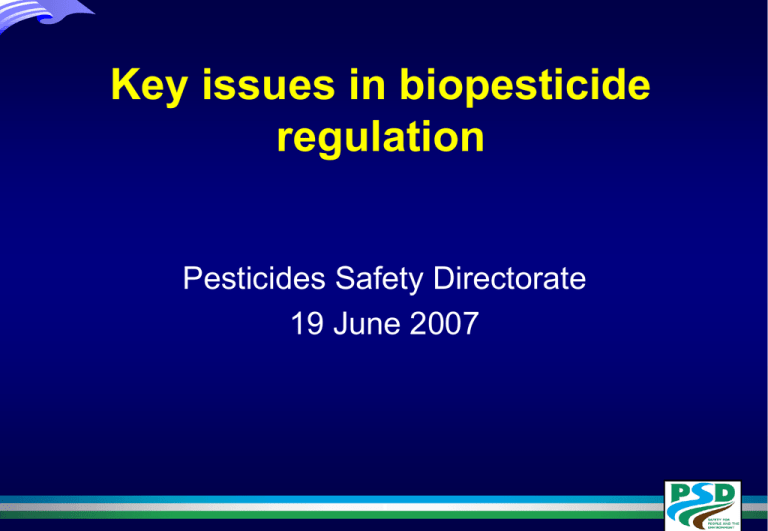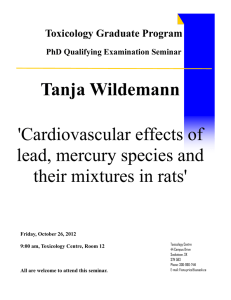Key issues in biopesticide regulation Pesticides Safety Directorate 19 June 2007
advertisement

Key issues in biopesticide regulation Pesticides Safety Directorate 19 June 2007 Challenges • Reaching out to non-traditional ‘customer’ – International Biological Manufacturers Association (IBMA) – Academic/research • Support at early stages in development • Fee structure and success rate dependent on quality of submission • Applicants understanding of regulatory ‘world’ Lessons learned from pilot scheme • Awareness of regulatory process and data requirements at the outset. e.g. GLP, GEP • Establish contacts (Confidence) • Pre-submission support and liaison with PSD • Use public domain data and appropriate cases – explain relevance • Ensure arguments are consistent across specialist areas Preliminary Data/Supporting Evidence • Laboratory/glasshouse studies • Public domain (published papers) – Mode of action, biological properties, Reasoned cases, host specificity, natural occurrence, identity (strain) – Relevance • Support all areas of risk assessment Common areas for risk assessment • Efficacy (biology specialists) can take lead • Common issues in risk assessment – Is it toxic ? – Does it produce any toxins ? – Can it infect humans ? – Host specificity ? – Will it infect native wild species (plants/organisms)? – What happens to the virus/micro-organism in the environment ? – How do applied levels/populations compare to natural ? Efficacy issues • • • • • • • More specific/unique mode of action Variation in performance Levels of control Temperature/humidity/rainfall effects Plot size/ trial design Impact of application equipment Use in conjunction with other pesticides Pesticide Chemistry • Identity – – To strain/isolate level – methods of analysis often non-conventional and these need to be validated – Demonstrate appropriateness and reliability • Microbial contaminants? • Residues data are required only where reasoned cases cannot exclude the possibilities of residues concern. Cases need to be robust Mammalian Toxicology • Substantial differences from data requirements for chemical pesticides • Less reliance on traditional toxicology studies Mammalian toxicology • Form of organism used in tests must be same as form humans will be exposed to • Applicant needs to establish whether the organism can infect/reproduce in humans • Information from humans exposed during manufacturing and development, or on background occurrence required Mammalian Toxicology • If related species are pathogenic, harmful or produce exotoxins → information to address those concerns for the proposed organism is required • If absence of significant hazard can be demonstrated • → an acceptable risk assessment can be achieved Operator exposure • No endpoints for living organisms, difficult to estimate levels of exposure • Accepted op ex modelling used for conventional chemicals is of limited use • Most organisms considered potentially sensitising, in absence of robust data PPE is required Operator exposure • Metabolites - possible difficulties determining levels present in a formulation - difficult to predict how levels vary during lifecycle of organism • Dynamic population – byproducts and their safety to workers re-entering crops for harvest Fate and Behaviour • Information on natural occurrence is crucial (microbe/substance/ toxin/metabolite etc). • Information on related strains/similar naturally occurring compounds can be useful (Sanco/10754/2005 rev.5) Fate and Behaviour • Care needed in use of such arguments • May not be appropriate if applied levels significantly higher or more persistent than naturally occurring range • May not be appropriate if applied in areas where it is not naturally occurring • If appropriate comparisons cannot be drawn, specific data on the organism/substance may be needed to address Data Requirements Ecotoxicology The risks to the major wildlife groups must be addressed. It may be possible to use published information and reasoned cases. If effects data are not available and exposure exists, dedicated studies will be needed. Data to enable the product to be correctly classified with respect to aquatic life.(?) Ecotoxicology Information on concentrations in the environment, persistence including potential for propagation, and other behaviour Natural occurrence in the situation in which it is to be used. If concentration not raised above the range of normal levels, unlikely to be a problem. Key points • Key is well thought out explanation of product, mode of action and central argument that can cut across many areas of risk assessment • Product developer knows their product best. • Make use of information from other uses e.g. food grade, cosmetic uses etc Key points • Applicant needs to come to PSD early in product development • Awareness of legislation and available guidance • Address all the areas detailed in relevant legislation – Could be data or a reasoned case if appropriate • Not making best use of published information – Inadequate explanation or relating results to their product – Not stating which data requirements it is addressing





